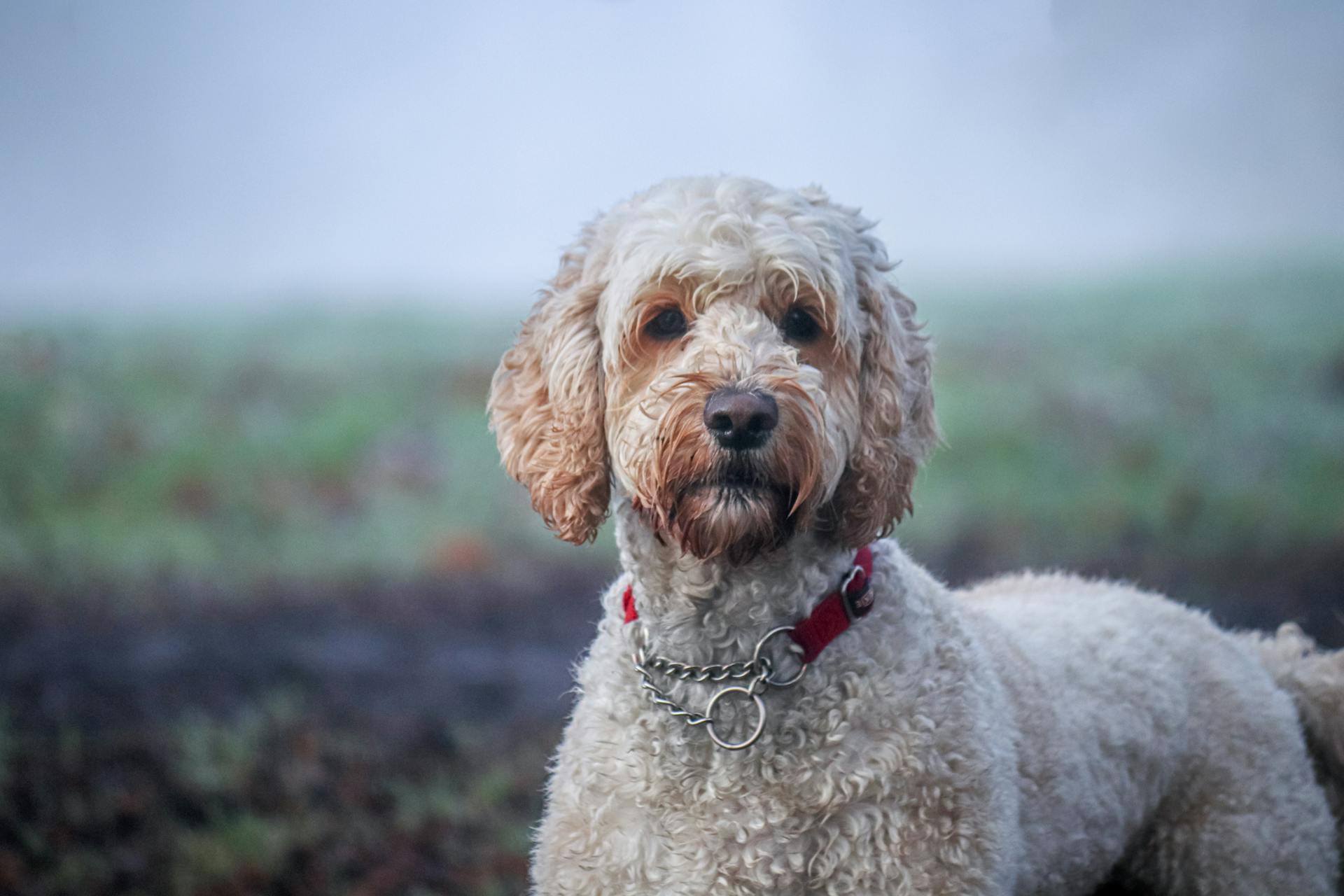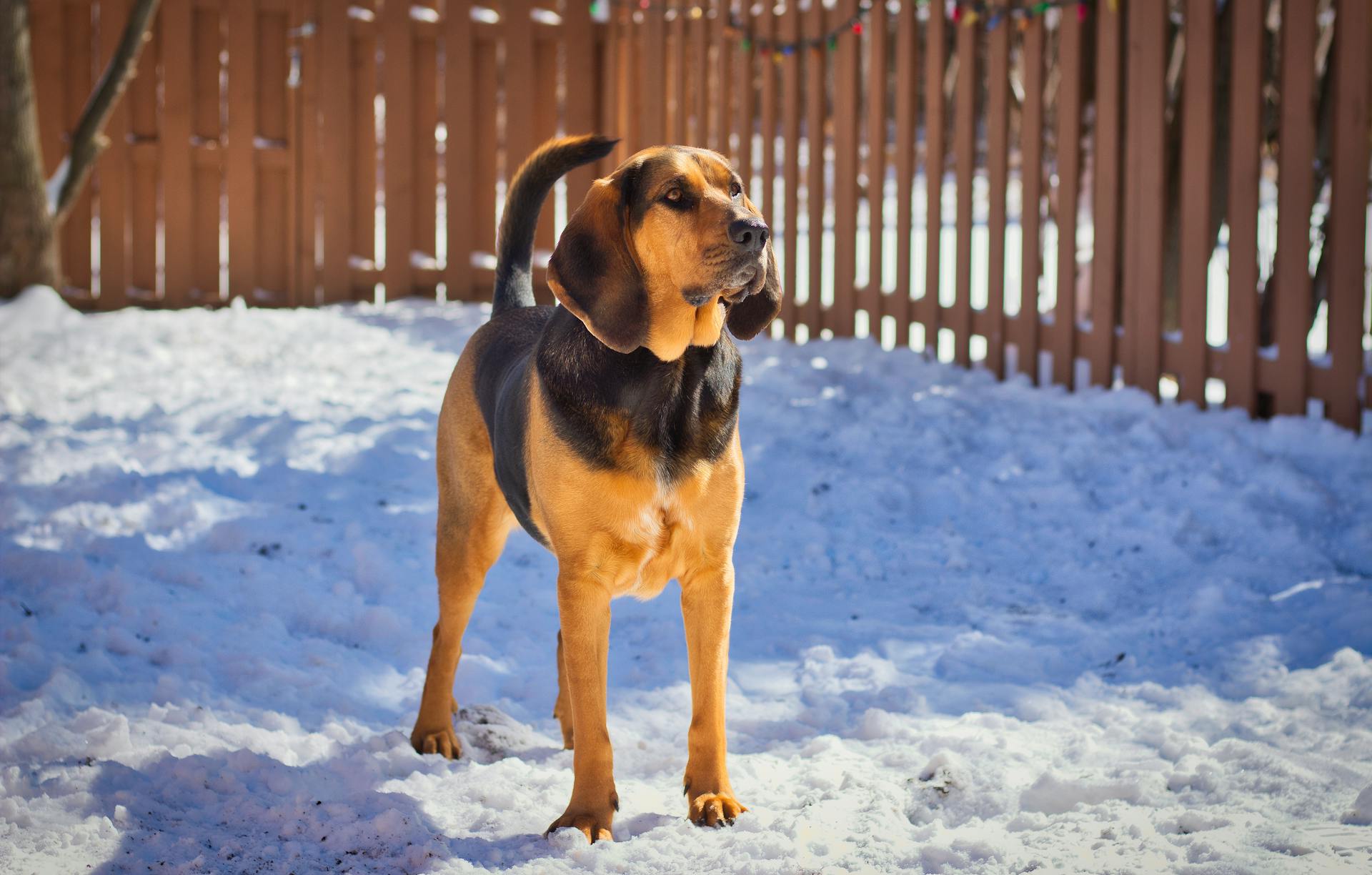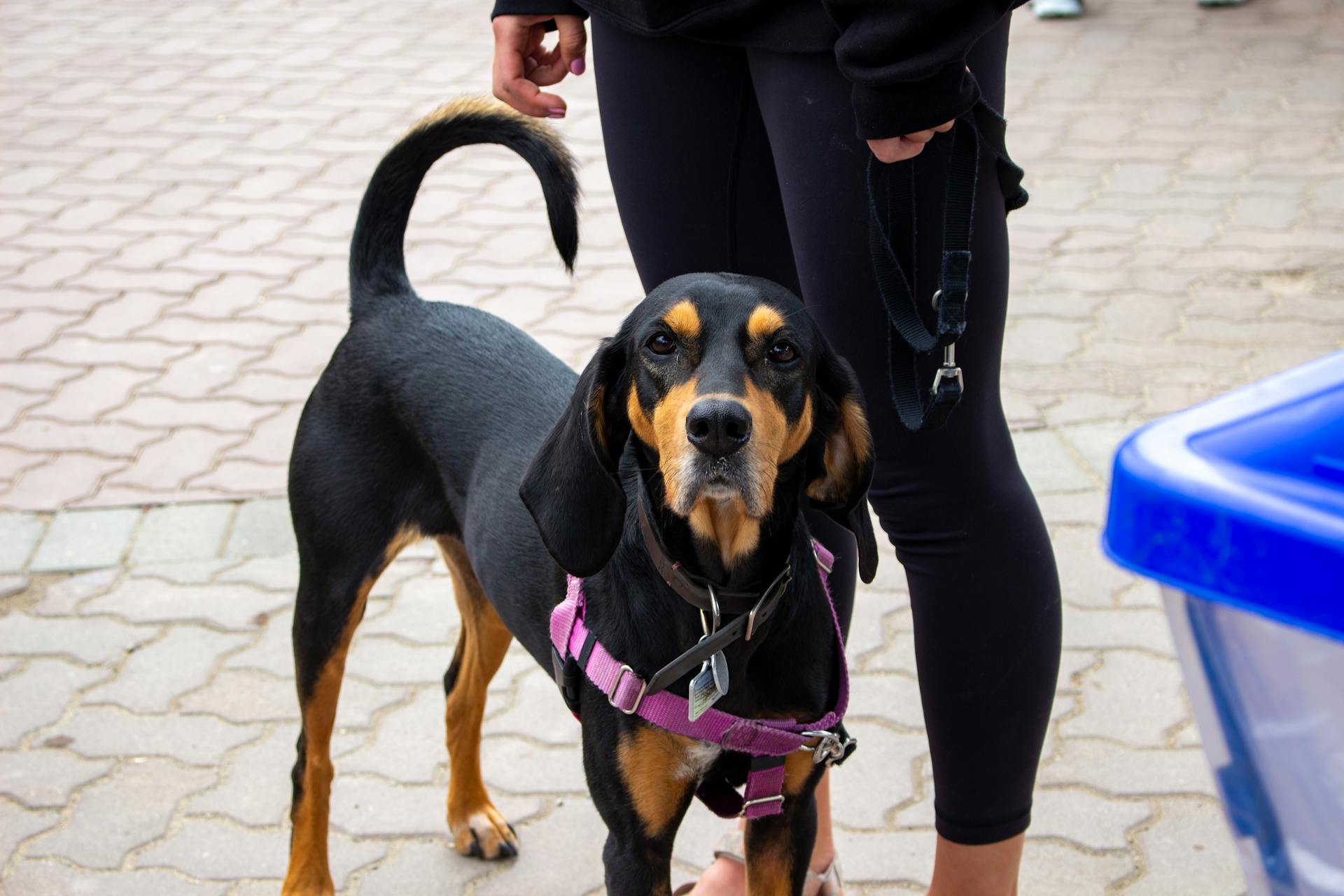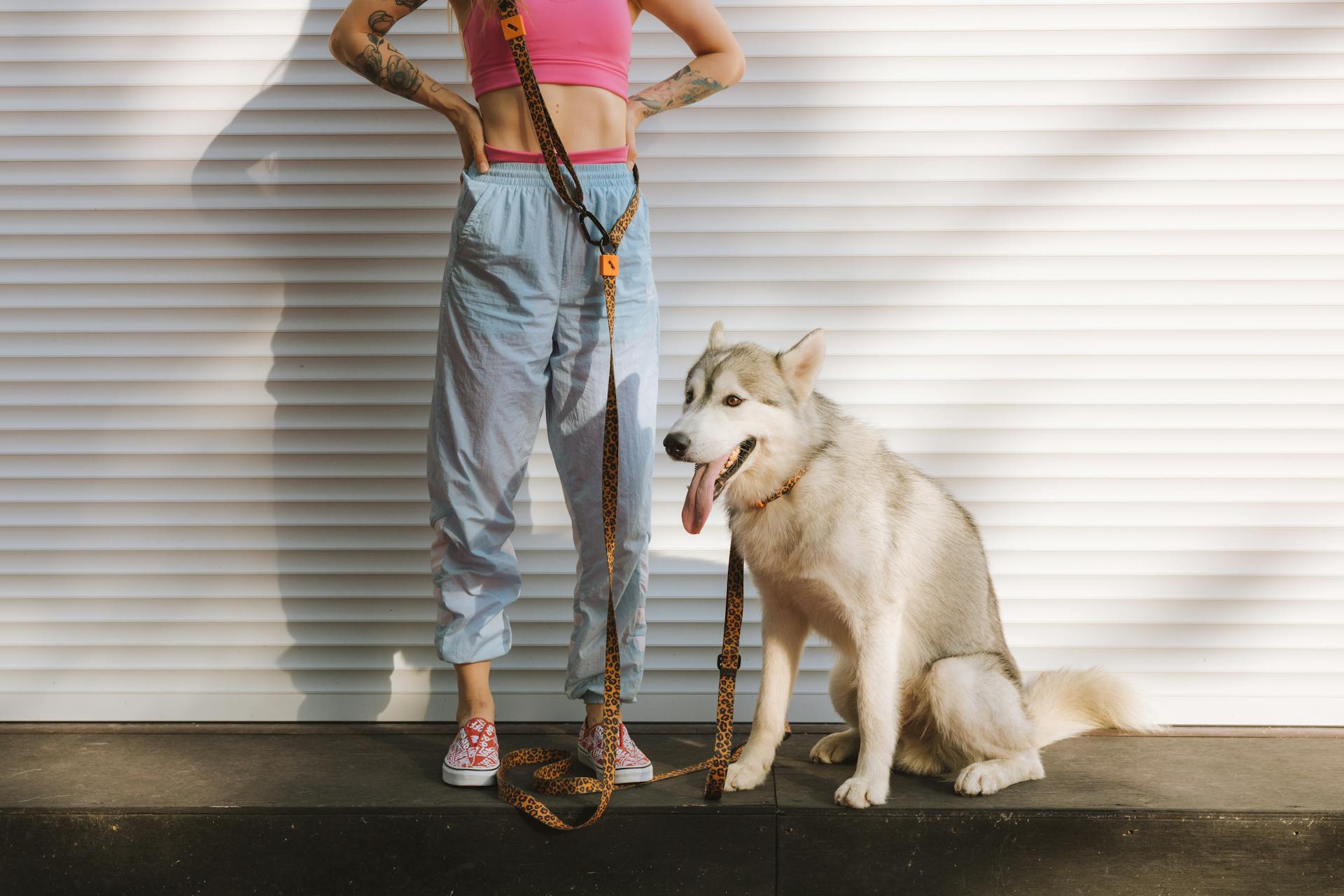
The Bloodhound Lab Mix is a unique and lovable breed that combines the best qualities of its parent breeds. They are known for their exceptional tracking ability, inherited from the Bloodhound's keen sense of smell.
Bloodhound Lab Mixes are generally good with children and make great family pets. Their calm and gentle nature makes them an excellent choice for families with kids.
They require regular exercise to stay happy and healthy, which is essential for their overall well-being. A daily walk or playtime in the yard can help them burn off energy and stay active.
Their short coats require minimal grooming, making them a low-maintenance pet. This is a bonus for busy families who don't have a lot of time to devote to grooming.
You might like: Bloodhound and Lab Mix Puppies
Why Get a Bloodhound Lab Mix
A Bloodhound Lab mix is a fantastic companion for many reasons. They're one of the friendliest dogs around, loving the company of humans and eager to please them.
Their friendly nature makes them a great fit for families with kids. With proper training, they'll be a gentle and patient companion for your little ones. They're not exactly velcro dogs, but they still enjoy following and staying by their owner's side.
Their sense of smell is truly amazing. Hounds are scent dogs, and their hybrid offspring will have a strong nose that can follow a scent for hours. You won't have to worry about losing your stuff as your mixed breed dog can find it for you.
Their athleticism and energy level make them a great companion for outdoor activities. They love going on adventures, whether it's hiking, camping, or swimming. A beach vacation will be more fun with a Bloodhound Lab mix by your side.
Here are some key characteristics to keep in mind when considering a Bloodhound Lab mix:
Breed Characteristics
The Bloodhound Lab mix is a unique and athletic breed, standing between 22 to 27 inches tall and weighing anywhere from 60 to 110 pounds.
Their muscular build and strong physique hint at their boundless energy, which requires regular exercise to keep them healthy and active. This includes walks, runs, and swims, but it's essential to exercise them within a fenced yard to prevent them from wandering off.
Their thick coats require extra care, especially during the hottest parts of the day, to prevent overheating. A daily routine that includes regular exercise, a balanced diet, and proper hygiene is crucial for their overall well-being.
Their sense of smell is combined with an instinct to track and follow, making them one of the top scent hounds in the world. This trait can be beneficial for tracking and locating missing people or pets, but it also means they might get into mischief if left unattended.
Here are some key characteristics of the Bloodhound Lab mix:
Their friendly and outgoing personalities make them a great addition to active families or households with kids. However, their high energy levels and love of tracking require careful consideration and attention to provide a stable and loving environment.
Puppies and Buying
Buying a Bloodhound Lab Mix puppy can be a daunting task, but with the right approach, you can find a healthy and happy companion. It's essential to do business with ethical breeders who prioritize the well-being of their dogs and puppies.
Look for breeders who utilize genetic testing with their stock to ensure they're healthy. You want to make sure your puppy is as healthy as can be, and hidden health issues can be costly and ruin a potentially happy relationship.
When meeting the breeder, take note of whether the area is clean and spacious. Insist on meeting the parent breeds and inquire about their health. The breeder should be able to provide you with papers attesting to the dog's health.
Some reputable breeders to consider are Greenfield Puppies and Lancaster Puppies. These breeders prioritize the well-being of their dogs and puppies, treating them like members of their own family.
Here's an interesting read: Lab Weimaraner Mix Breeders

If you're lucky enough to have a Bloodhound Lab mix, you'll want to ensure they remain healthy and lively through regular exercise. This can include taking them for walks, runs, and swims. Just remember to exercise them within a fenced yard to prevent them from wandering off.
Here are some key questions to ask a breeder:
- What genetic testing have you done with your stock?
- Can I meet the parent breeds and see their health records?
- Do you have a clean and spacious area for the puppies?
- Can I see proof of health checks for the puppies?
By doing your research and asking the right questions, you can find a reputable breeder and bring home a happy and healthy Bloodhound Lab mix puppy.
Care and Grooming
When you have a bloodhound lab mix, grooming is a must. Regular brushing is essential to keep their coat sleek and tangle-free, so aim to brush their coat once a day, five to six days a week.
A daily brushing schedule will also help reduce shedding, especially for labbloodhounds that tend to shed more. Don't forget to check their wrinkles daily, wiping them with a baby wipe or washcloth and drying thoroughly to prevent skin irritation.
Make sure to brush your bloodhound lab mix's teeth regularly, as they have very strong teeth and are notorious chewers. Regular ear checks are also crucial, especially for breeds with draped ears like the lab hound, to prevent infections from circulating air.
Take a look at this: Bloodhound English Mastiff Mix
Health and Well Being
As a responsible dog owner, it's essential to be aware of the potential health issues that can affect your Bloodhound Lab mix. Skin allergies can be a complication that arises from the Labrador side, manifesting in various forms.
Bloating and cancer are significant concerns, particularly inherited from the Bloodhound side, which are the main causes of death in this breed. This is why it's crucial to monitor your dog's health closely.
Exercise-related injuries are also a risk, given the breed's athletic and active nature. These can include broken tails, pulled muscles, or split pads.
Some common health issues that may affect your Bloodhound Lab mix include:
- Thyroid disorders
- Eye problems
- Progressive retinal atrophy (PRA)
- Luxating patella
- Ear infections
- Arthritis
Additionally, your dog may be prone to cardiac problems, gastric dilatation-volvulus (GDV), or bloat, hip dysplasia, and elbow dysplasia.
Health and Conditions
As a responsible dog owner, it's essential to be aware of the potential health issues that can affect your Labloodhound. Skin allergies can manifest in various forms and are inherited from the Labrador side.
The Hound ancestry in your Labloodhound can make it susceptible to back problems, especially if one of the parent breeds is a Dachshund.
Your Labloodhound's large size means it's at risk for common afflictions like elbow dysplasia, hip dysplasia, and progressive retinal atrophy.
Bloating and cancer are significant concerns for this breed, with bloat being a major cause of death.
Exercise-related injuries like a broken tail, pulled muscles, or split pads can occur due to your Labloodhound's athletic and active nature.
Here are some potential health issues to watch out for:
- Elbow dysplasia
- Hip dysplasia
- Progressive retinal atrophy
- Back problems (especially with Dachshund ancestry)
- Bloating and cancer
- Exercise-related injuries (broken tail, pulled muscles, split pads)
Well Being
Taking care of your mental health is crucial for overall well-being. Research suggests that 1 in 4 people will experience a mental health issue each year.
Engaging in regular physical activity can boost mood and reduce stress. Aim for at least 30 minutes of moderate-intensity exercise per day.
Mindfulness practices such as meditation and deep breathing can help calm the mind and reduce anxiety. Even just 5-10 minutes a day can make a significant difference.
Getting enough sleep is essential for both physical and mental health. Aim for 7-9 hours of sleep per night to help regulate mood and reduce stress.
Eating a balanced diet rich in whole foods can also support mental health. Focus on consuming plenty of fruits, vegetables, whole grains, and lean proteins.
Taking breaks and practicing self-care can help manage stress and improve overall well-being. Whether it's reading a book, taking a walk, or simply enjoying a cup of tea, make time for activities that bring you joy.
Nutrition and Exercise
Your bloodhound lab mix needs regular exercise to stay healthy, so plan for at least an hour of physical activity every day. This can be a mix of running, walking, or playing fetch in a park.
Spending time exercising with your pet will also help strengthen your bond. Your bloodhound lab mix loves the outdoors, so trips to the beach or hikes are a great way to get some exercise together.
To meet their energy needs, your bloodhound lab mix requires about twenty miles of walking or running distance per week. Be sure to avoid exercising on hot days to keep them safe and comfortable.
Here are some recommended toys for your bloodhound lab mix:
- Nylabone Dura Chew: A great toy for strong chewers, with various textures to keep your dog interested and healthy.
- KONG Extreme: A durable toy that can be filled with treats and will keep your dog occupied for hours.
- Mammoth Flossy Rope: A large, cotton rope toy that's perfect for tugging and playing, with fibers that work as floss for your dog's teeth.
In terms of food, your bloodhound lab mix will depend on its size and age for nutritional requirements. As a general rule, big breeds like your bloodhound lab mix should eat food made specifically for dogs of their caliber, such as large breed dry dog food.
Food Requirements
Your Lab Hound mix will have different food requirements depending on its size and age. As a puppy, it can eat a variety of puppy food brands, but as it grows older, its nutritional needs will change.
Older dogs need a special type of food that meets their specific needs. This is why senior dry dog food is recommended for Lab Hounds and their mixes.
Lab Hound mixes are big breeds, so they'll need to eat large portions of food. However, it's essential to prevent overeating, so choose a high-quality large breed dry dog food.
To keep your dog healthy and happy, consider sprinkling some snacks throughout the day. Snacks can even be used as a tool for positive reinforcement during training.
Here are some great food options for your Lab Hound mix:
- Wellness Core Dog Food: 38% protein, with chicken meal, deboned chicken, and turkey meal as its first three ingredients.
- Dog For Dog Food: Made from natural ingredients and delicious dog treats for training sessions.
- K9 Natural Grain-Free Puppy Formula: Freeze-dried grass-fed New Zealand beef and other fruits and vegetables for optimal growth.
- Natural Balance Original Ultra Whole Body Health Large Breed Recipe: High protein and nutrients for lean muscle mass and healthy coat.
- Nutra Thrive dog food supplement: Added energy boost for big Lab Hound crosses.
Exercise Requirements
Your Hound Lab mix will require at least an hour of exercise every day. This is essential to keep them physically and mentally healthy.
Spending time exercising or playing with your pet will also help strengthen the bond between the two of you. Regular exercise will prevent boredom and destructive behavior.
Your Hound Lab mix will need about twenty miles of walking or running distance a week. This can be achieved by running around the park, playing Frisbee, or hiking up a mountain.
On hot days, it's best to avoid strenuous activities to prevent heat exhaustion. Your dog will love the outdoors and swimming, so trips to the beach or a walk along the shoreline will be a great treat.
Training and Compatibility
Training a bloodhound lab mix requires patience and consistency. This breed can be stubborn and independent, making it essential to focus on positive reinforcement training.
To start training early is crucial, as an eight-week-old pup will soak up information quickly. Enrolling in puppy kindergarten classes or exposing your dog to friends, family, and other animals at home can help with socialization.
Training should be reinforced with consistent actions, praise, and rewards. A consistent routine will help your dog develop good habits and reduce the risk of a headstrong dog.
Here are some key takeaways to consider when training your bloodhound lab mix:
- Patience and consistency are key.
- Start training early, ideally as soon as you bring your puppy home.
- Socialization should also begin early to help your dog develop proper social skills.
Training
Training your Bloodhound Lab mix requires patience and consistency. They can inherit the strong instinct to follow scent tracks from their Bloodhound parent, making training a challenge if not done correctly.
Labradors are generally easy to train, but the Hound's stubbornness can make them less receptive to training. This is why positive reinforcement training is essential for this breed.
Training should start early, ideally from an eight-week-old puppy. Consistency and patience are key, and training should be reinforced with praise, rewards, and practice.
Socialization is also crucial for this breed, and it's best to start early, even from an eight-week-old puppy. Enrolling them in puppy kindergarten classes or exposing them to friends, family, and other animals at home can help.
The success of training and socialization depends on the skill of the trainer and the owner. A positive reinforcement training approach is best for this breed, and consistency is key.
Here are some tips to keep in mind when training your Bloodhound Lab mix:
- Patience and consistency are key.
- Train early, ideally from an eight-week-old puppy.
- Socialization should start early, even from an eight-week-old puppy.
Pet Compatibility
Labloodhounds are known for their amiable nature towards other animals, making them a great addition to multi-pet households.
Their composed temperament means they seldom engage in conflicts with smaller dogs or felines, allowing for peaceful and harmonious coexistence.
However, it's essential to socialize your Labloodhound puppy with other dogs to ensure they develop proper social skills.
This way, they can learn to differentiate between playtime with family pets and their natural hunting instincts.
Labradors are such lovable and pleasant dogs when they're appropriately socialized, but Bloodhounds may have different ranges of endurance around kids, strangers, or other animals.
Socializing your blended breed pup from an early age is crucial to help them be more comfortable and less fearful or aggressive around others.
The Bloodhound and Labrador Retriever combination is sure to make friends with everybody they meet, though they may need a little time to warm up to new people.
They'll be the happiest dogs around with a loving family and some fun outdoor activities!
Frequently Asked Questions
How big will a Lab Bloodhound mix get?
A Lab Bloodhound mix typically stands between 22 to 27 inches tall and weighs between 60 to 110 pounds. Their athletic build makes them a sturdy companion.
How long do Lab Bloodhounds live?
Lab Bloodhounds, also known as Hound Lab Mixes, typically live for 10 to 14 years with proper care. Their lifespan can vary depending on individual factors, but with regular veterinary attention and proper nutrition, they can thrive for a decade or more.
Featured Images: pexels.com


